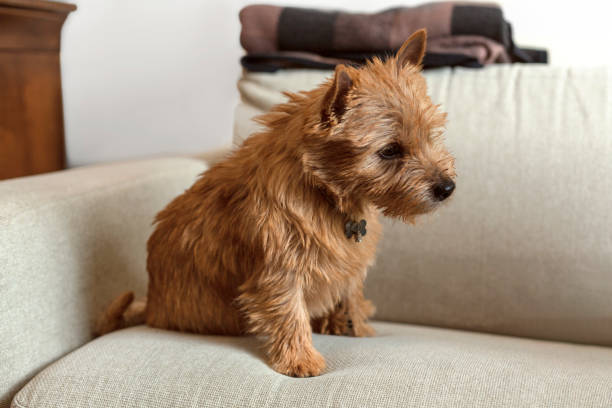Norwich Terrier

Breed History:
The Norwich Terrier originated in East Anglia, England, alongside the Norfolk Terrier. Both were originally one breed, developed in the late 19th and early 20th centuries to control vermin on farms and hunt small game. Students at Cambridge University also kept them as rats and companions.
The primary difference between the two breeds lies in the ears: the Norwich Terrier has erect, pointed ears, while the Norfolk has drop ears. The breeds were officially split in the UK in 1964 and in the U.S. in 1979.
Height: 23-25 cm
Weight: 4-6 kg
Size – Small
Life Expectancy: 12–15 years

Breed Appearance:
The Norwich Terrier is a compact, sturdy, and low-set dog with a fox-like expression, erect ears, and bright, alert eyes. It has a short, strong muzzle and a slightly arched neck.
The harsh, wiry coat lies close to the body and comes in red, wheaten, black and tan, or grizzle. A soft undercoat provides insulation. The tail is typically of medium length and carried upright.
Breed Type – Companion/Vermin Hunter:
Originally bred to hunt vermin and foxes in packs, the Norwich Terrier remains an active and tenacious breed. It is bold, affectionate, and enjoys being around people.
Though fearless and energetic, the Norwich is also known for being more laid-back than some terriers, making it well-suited to family life. It generally gets along with other dogs but may chase small pets due to a strong prey drive.

Training:
The Norwich Terrier is intelligent and eager to learn, but can be willful. Consistent, positive reinforcement is the best training approach.
They respond well to praise and treats, especially when sessions are kept fun and engaging. Early socialisation is important to prevent shyness or over-alertness.
Health & Care:
Norwich Terriers are generally healthy but may be prone to:
-
Upper airway syndrome (narrow airways due to small size)
-
Hip dysplasia
-
Epilepsy
-
Patellar luxation
-
Eye problems (e.g., cataracts)
Regular veterinary checkups, health screenings, and maintaining a healthy weight are key to their longevity.

Living Conditions:
The Norwich Terrier adapts well to various living environments, including apartments, as long as it receives enough physical and mental exercise.
It prefers to be close to its people and may develop separation anxiety if left alone too long. A secure yard is ideal for supervised outdoor play.
Exercise:
Although small, the Norwich Terrier is energetic and needs around 45 minutes to 1 hour of daily activity. This can include brisk walks, games, and interactive toys.
They also enjoy digging, chasing, and exploring, so off-leash play in a fenced yard or participation in agility or earthdog trials is beneficial.
Grooming:
-
Weekly brushing helps remove dead hairs and reduce matting
-
Hand-stripping a few times a year maintains the correct coat texture (optional for pets)
-
Regular nail trimming, ear cleaning, and dental care are important
They are moderate shedders, but grooming is relatively easy with regular upkeep.

Advantages:
-
Cheerful, affectionate, and adaptable
-
Compact size suited for small homes or apartments
-
Excellent watchdog—alert and vocal
-
Sociable with people and generally friendly with dogs
-
Intelligent and easy to train with the right approach
-
Hardy and long-lived
Disadvantages:
-
Can be strong-willed and occasionally stubborn
-
High prey drive—not ideal with small animals
-
May bark excessively if under-stimulated
-
Needs consistent attention and companionship
-
Requires professional grooming (hand-stripping) for show dogs
-
Some lines are prone to respiratory or neurological issues

